+ Open data
Open data
- Basic information
Basic information
| Entry | Database: PDB / ID: 4irj | |||||||||
|---|---|---|---|---|---|---|---|---|---|---|
| Title | Structure of the mouse CD1d-4ClPhC-alpha-GalCer-iNKT TCR complex | |||||||||
 Components Components |
| |||||||||
 Keywords Keywords | IMMUNE SYSTEM / antigen presentation / glycolipid / NKT cells | |||||||||
| Function / homology |  Function and homology information Function and homology informationregulation of immature T cell proliferation in thymus / positive regulation of NK T cell activation / positive regulation of NK T cell differentiation / NK T cell differentiation / endogenous lipid antigen binding / antigen processing and presentation, exogenous lipid antigen via MHC class Ib / positive thymic T cell selection / positive regulation of macrophage activation / Endosomal/Vacuolar pathway / DAP12 interactions ...regulation of immature T cell proliferation in thymus / positive regulation of NK T cell activation / positive regulation of NK T cell differentiation / NK T cell differentiation / endogenous lipid antigen binding / antigen processing and presentation, exogenous lipid antigen via MHC class Ib / positive thymic T cell selection / positive regulation of macrophage activation / Endosomal/Vacuolar pathway / DAP12 interactions / Antigen Presentation: Folding, assembly and peptide loading of class I MHC / ER-Phagosome pathway / DAP12 signaling / Immunoregulatory interactions between a Lymphoid and a non-Lymphoid cell / antigen processing and presentation / positive regulation of interleukin-4 production / regulation of immune response / cellular defense response / T cell receptor binding / Neutrophil degranulation / positive regulation of interleukin-2 production / cellular response to iron(III) ion / negative regulation of forebrain neuron differentiation / antigen processing and presentation of exogenous protein antigen via MHC class Ib, TAP-dependent / iron ion transport / peptide antigen assembly with MHC class I protein complex / regulation of iron ion transport / regulation of erythrocyte differentiation / HFE-transferrin receptor complex / response to molecule of bacterial origin / MHC class I peptide loading complex / T cell mediated cytotoxicity / positive regulation of T cell cytokine production / antigen processing and presentation of endogenous peptide antigen via MHC class I / MHC class I protein complex / positive regulation of receptor-mediated endocytosis / negative regulation of neurogenesis / cellular response to nicotine / positive regulation of T cell mediated cytotoxicity / multicellular organismal-level iron ion homeostasis / positive regulation of type II interferon production / phagocytic vesicle membrane / negative regulation of epithelial cell proliferation / sensory perception of smell / positive regulation of cellular senescence / late endosome / T cell differentiation in thymus / negative regulation of neuron projection development / protein refolding / protein homotetramerization / amyloid fibril formation / intracellular iron ion homeostasis / learning or memory / early endosome / lysosome / endosome membrane / lysosomal membrane / innate immune response / external side of plasma membrane / structural molecule activity / Golgi apparatus / protein homodimerization activity / extracellular space / cytosol Similarity search - Function | |||||||||
| Biological species |   Homo sapiens (human) Homo sapiens (human) | |||||||||
| Method |  X-RAY DIFFRACTION / X-RAY DIFFRACTION /  SYNCHROTRON / SYNCHROTRON /  MOLECULAR REPLACEMENT / Resolution: 3 Å MOLECULAR REPLACEMENT / Resolution: 3 Å | |||||||||
 Authors Authors | Nemcovic, M. / Zajonc, D.M. | |||||||||
 Citation Citation |  Journal: J.Immunol. / Year: 2013 Journal: J.Immunol. / Year: 2013Title: Enhanced TCR footprint by a novel glycolipid increases NKT-dependent tumor protection. Authors: Aspeslagh, S. / Nemcovic, M. / Pauwels, N. / Venken, K. / Wang, J. / Van Calenbergh, S. / Zajonc, D.M. / Elewaut, D. | |||||||||
| History |
|
- Structure visualization
Structure visualization
| Structure viewer | Molecule:  Molmil Molmil Jmol/JSmol Jmol/JSmol |
|---|
- Downloads & links
Downloads & links
- Download
Download
| PDBx/mmCIF format |  4irj.cif.gz 4irj.cif.gz | 175.4 KB | Display |  PDBx/mmCIF format PDBx/mmCIF format |
|---|---|---|---|---|
| PDB format |  pdb4irj.ent.gz pdb4irj.ent.gz | 134.1 KB | Display |  PDB format PDB format |
| PDBx/mmJSON format |  4irj.json.gz 4irj.json.gz | Tree view |  PDBx/mmJSON format PDBx/mmJSON format | |
| Others |  Other downloads Other downloads |
-Validation report
| Summary document |  4irj_validation.pdf.gz 4irj_validation.pdf.gz | 998.3 KB | Display |  wwPDB validaton report wwPDB validaton report |
|---|---|---|---|---|
| Full document |  4irj_full_validation.pdf.gz 4irj_full_validation.pdf.gz | 1005.7 KB | Display | |
| Data in XML |  4irj_validation.xml.gz 4irj_validation.xml.gz | 34.1 KB | Display | |
| Data in CIF |  4irj_validation.cif.gz 4irj_validation.cif.gz | 44 KB | Display | |
| Arichive directory |  https://data.pdbj.org/pub/pdb/validation_reports/ir/4irj https://data.pdbj.org/pub/pdb/validation_reports/ir/4irj ftp://data.pdbj.org/pub/pdb/validation_reports/ir/4irj ftp://data.pdbj.org/pub/pdb/validation_reports/ir/4irj | HTTPS FTP |
-Related structure data
- Links
Links
- Assembly
Assembly
| Deposited unit | 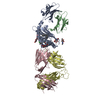
| ||||||||
|---|---|---|---|---|---|---|---|---|---|
| 1 |
| ||||||||
| Unit cell |
|
- Components
Components
-Protein , 3 types, 3 molecules ABD
| #1: Protein | Mass: 32632.668 Da / Num. of mol.: 1 / Fragment: UNP residues 19-298 Source method: isolated from a genetically manipulated source Source: (gene. exp.)   |
|---|---|
| #2: Protein | Mass: 11660.350 Da / Num. of mol.: 1 Source method: isolated from a genetically manipulated source Source: (gene. exp.)   |
| #4: Protein | Mass: 27026.998 Da / Num. of mol.: 1 Source method: isolated from a genetically manipulated source Source: (gene. exp.) Mus musculus, Homo sapiens Gene: Vbeta8.2 (mouse variable domain, human constant domain) Plasmid: pET22b / Production host:  |
-Antibody , 1 types, 1 molecules C
| #3: Antibody | Mass: 23055.621 Da / Num. of mol.: 1 Source method: isolated from a genetically manipulated source Source: (gene. exp.) Mus musculus, Homo sapiens Gene: Valpha14 (mouse variable domain, human constant domain) Plasmid: pET22b / Production host:  |
|---|
-Sugars , 2 types, 3 molecules 
| #5: Polysaccharide | 2-acetamido-2-deoxy-beta-D-glucopyranose-(1-4)-[alpha-L-fucopyranose-(1-6)]2-acetamido-2-deoxy-beta- ...2-acetamido-2-deoxy-beta-D-glucopyranose-(1-4)-[alpha-L-fucopyranose-(1-6)]2-acetamido-2-deoxy-beta-D-glucopyranose |
|---|---|
| #6: Sugar |
-Non-polymers , 2 types, 14 molecules 


| #7: Chemical | ChemComp-1L9 / |
|---|---|
| #8: Water | ChemComp-HOH / |
-Details
| Has protein modification | Y |
|---|
-Experimental details
-Experiment
| Experiment | Method:  X-RAY DIFFRACTION / Number of used crystals: 1 X-RAY DIFFRACTION / Number of used crystals: 1 |
|---|
- Sample preparation
Sample preparation
| Crystal | Density Matthews: 3.05 Å3/Da / Density % sol: 59.73 % |
|---|---|
| Crystal grow | Temperature: 295.5 K / Method: vapor diffusion, sitting drop / pH: 7.5 Details: 20% polyethylene glycol 4000, 0.2M sodium thiocyanate, pH 7.5, VAPOR DIFFUSION, SITTING DROP, temperature 295.5K |
-Data collection
| Diffraction | Mean temperature: 100 K |
|---|---|
| Diffraction source | Source:  SYNCHROTRON / Site: SYNCHROTRON / Site:  SSRL SSRL  / Beamline: BL9-2 / Wavelength: 0.9795706 Å / Beamline: BL9-2 / Wavelength: 0.9795706 Å |
| Detector | Type: MARMOSAIC 325 mm CCD / Detector: CCD / Date: Jan 1, 2012 |
| Radiation | Monochromator: Double crystal monochromator / Protocol: MAD / Monochromatic (M) / Laue (L): M / Scattering type: x-ray |
| Radiation wavelength | Wavelength: 0.9795706 Å / Relative weight: 1 |
| Reflection | Resolution: 3→50 Å / Num. all: 22997 / Num. obs: 21794 / % possible obs: 98 % / Observed criterion σ(F): 0 / Observed criterion σ(I): 0 |
| Reflection shell | Resolution: 3→3.11 Å / % possible all: 100 |
- Processing
Processing
| Software | Name: REFMAC / Version: 5.6.0104 / Classification: refinement | |||||||||||||||||||||||||||||||||||||||||||||
|---|---|---|---|---|---|---|---|---|---|---|---|---|---|---|---|---|---|---|---|---|---|---|---|---|---|---|---|---|---|---|---|---|---|---|---|---|---|---|---|---|---|---|---|---|---|---|
| Refinement | Method to determine structure:  MOLECULAR REPLACEMENT / Resolution: 3→38.35 Å / Cor.coef. Fo:Fc: 0.923 / Cor.coef. Fo:Fc free: 0.892 / SU B: 12.171 / SU ML: 0.237 / Cross valid method: THROUGHOUT / σ(F): 2 / ESU R Free: 0.381 / Stereochemistry target values: MAXIMUM LIKELIHOOD / Details: HYDROGENS HAVE BEEN USED IF PRESENT IN THE INPUT MOLECULAR REPLACEMENT / Resolution: 3→38.35 Å / Cor.coef. Fo:Fc: 0.923 / Cor.coef. Fo:Fc free: 0.892 / SU B: 12.171 / SU ML: 0.237 / Cross valid method: THROUGHOUT / σ(F): 2 / ESU R Free: 0.381 / Stereochemistry target values: MAXIMUM LIKELIHOOD / Details: HYDROGENS HAVE BEEN USED IF PRESENT IN THE INPUT
| |||||||||||||||||||||||||||||||||||||||||||||
| Solvent computation | Ion probe radii: 0.8 Å / Shrinkage radii: 0.8 Å / VDW probe radii: 1.2 Å / Solvent model: BABINET MODEL WITH MASK | |||||||||||||||||||||||||||||||||||||||||||||
| Displacement parameters | Biso mean: 41.883 Å2
| |||||||||||||||||||||||||||||||||||||||||||||
| Refinement step | Cycle: LAST / Resolution: 3→38.35 Å
| |||||||||||||||||||||||||||||||||||||||||||||
| Refine LS restraints |
| |||||||||||||||||||||||||||||||||||||||||||||
| LS refinement shell | Resolution: 3.001→3.078 Å / Total num. of bins used: 20
|
 Movie
Movie Controller
Controller




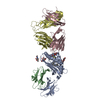
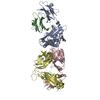
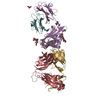
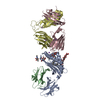
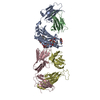
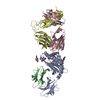
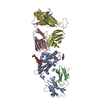
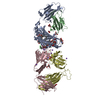
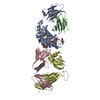
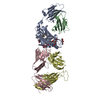
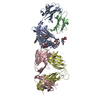
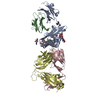
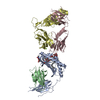
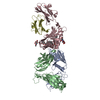
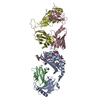
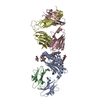
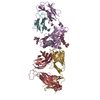
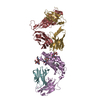
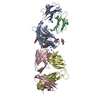
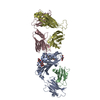
 PDBj
PDBj












